Video of explanation of Kobe beef brand management and interviews with producers and meat centers
What is Kobe Beef?
Kobe Beef is Japan’s leading brand of beef.
Kobe Beef has a long history and has maintained its pure bloodline from the Edo period to the present day.
Only Tajima Beef that meets the most stringent screening standards is referred to as Kobe Beef among Japanese Wagyu beef.
Kobe Beef is recognized not only in Japan but also overseas.

The Kobe Beef Marketing and Distribution Promotion Association (KBMDPA) ensures that safe and secure Kobe beef is available to as many people as possible.
Purpose and Objectives of KBMDPA
- Clarify the definition of Kobe Beef.
- Provide “Certificate of Kobe Beef” for meat meeting the Kobe Beef definition.
- Specify approved suppliers among stores and farmers for Kobe Beef.
- Install bronze statuettes at designated locations to let consumers know that the store sells Kobe Beef.
Before Kobe beef reaches consumers, all producers and sellers must be registered as designated by the Kobe Meat Distribution Promotion Council.
Kobe Beef Distribution System
First, Tajima Beef, the “motoushi” (purebred seedstock cattle) for Kobe Beef, is shipped to the Tajima Beef livestock market in the prefecture by designated breeders.
They are then auctioned off to designated fattening farms at the livestock market and fattened for about two years.

[Designation] Tajima Beef Breeding Producer


Tajima Cattle Livestock Market in the Prefecture


[Designation] fatting farmers

The matured Tajima Beef is transported to a designated meat center in Hyogo Prefecture, where it undergoes meticulous inspections by the Japan Meat Grading Association, passing rigorous examinations. Once granted the prestigious certification as Kobe Beef, it tantalizes taste buds worldwide.
Subsequently, certified Kobe Beef is presented for auction by a designated registration store at a specialized meat market in Hyogo Prefecture.

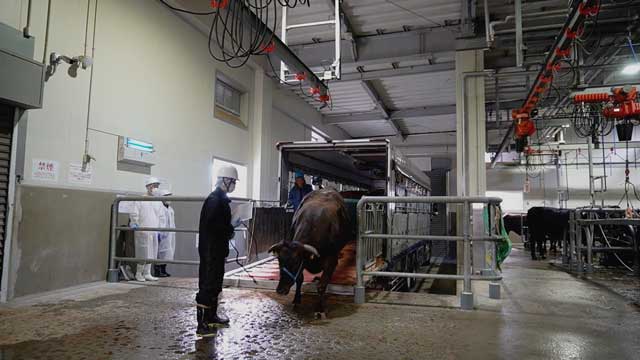
[Designation] Meat Center in Hyogo Prefecture

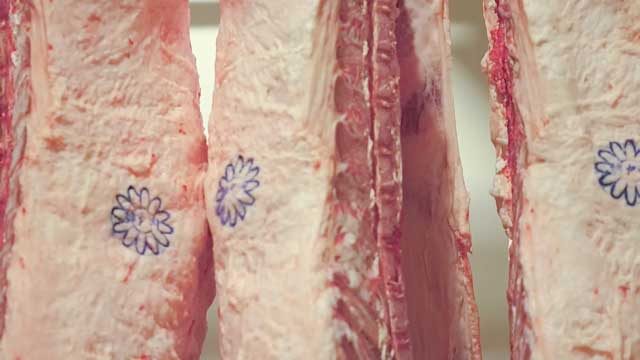
Japan Meat Grading Association
(JMGA)

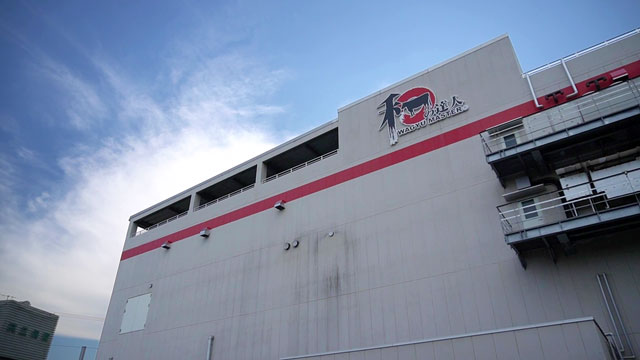
[Designation] Meat wholesale market in Hyogo prefecture
Confirmation by Organization Members Commissioned by the Kobe Beef Marketing & Distribution Promotion Association
- Confirmation of shipping cow
- Carcass confirmation
- Imprint on carcass of Kobe beef / Tajima beef mark
- Issuance of “Tajima Beef Certificate”
- Issuance of “Kobe Beef Certificate”
- Tajima cattle pedigree certification system input

It is subsequently distributed to designated retailers and restaurants, ensuring that consumers can savor the authenticity of Kobe Beef.


[Designation] Meat wholesale store/retail store

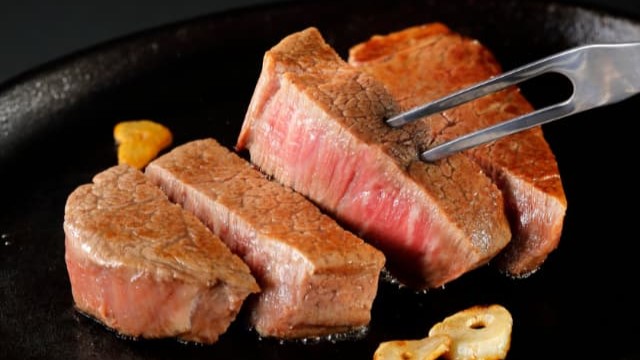
[Designation] Restaurant
Regarding Handling of Kobe Beef
Kobe Beef can be handled by wholesalers, retailers, and restaurants registered and approved by the Kobe Beef Marketing & Distribution Promotion Association.
Designated registration stores must prominently display the Association’s Certificate of Designation, Membership Certificate, and Kobe Beef declaration plaque for consumers to see. Stores are also required to display the Kobe Beef Certificate of Authenticity for the Kobe Beef they sell.
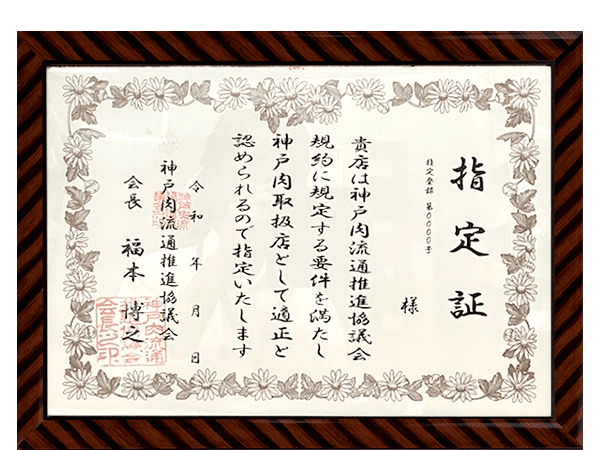
Certificate of Designation

Membership Certificate (Bronze statue)
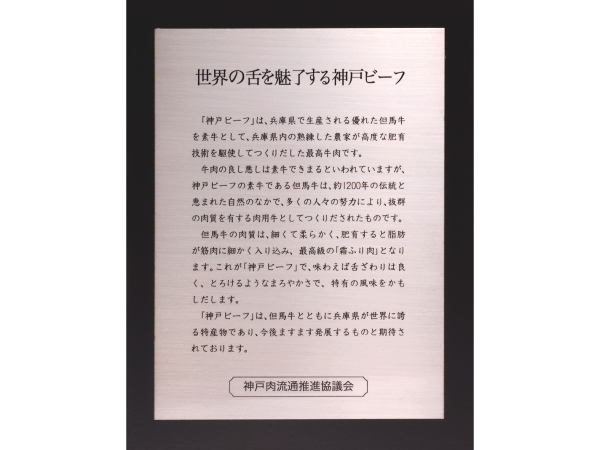
Kobe Beef declaration plaque
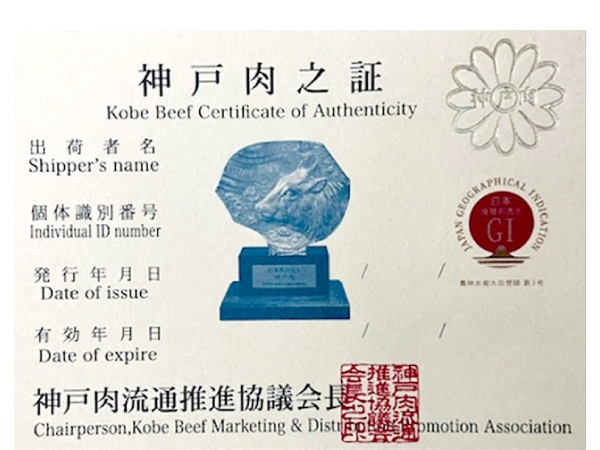
Kobe beef Certificate
Handling Procedures for Kobe Beef
Acquisition of Kobe Beef Association Membership
Becoming Designated Registered Members of the Kobe Beef Association
Apply to a designated registered member already handling Kobe Beef.
Designated registered members should submit their applications to the association using the provided form.
The designated registered member applying serves as the recommender, supplier, and responsible person for the vendor applying.
The Kobe Beef Association will notify you of the approval of your registration, and you can complete the process by paying the admission fee.
After completing the registration process, approved businesses will be listed as registered designated members on the Kobe Beef Association website, allowing them to handle Kobe beef.
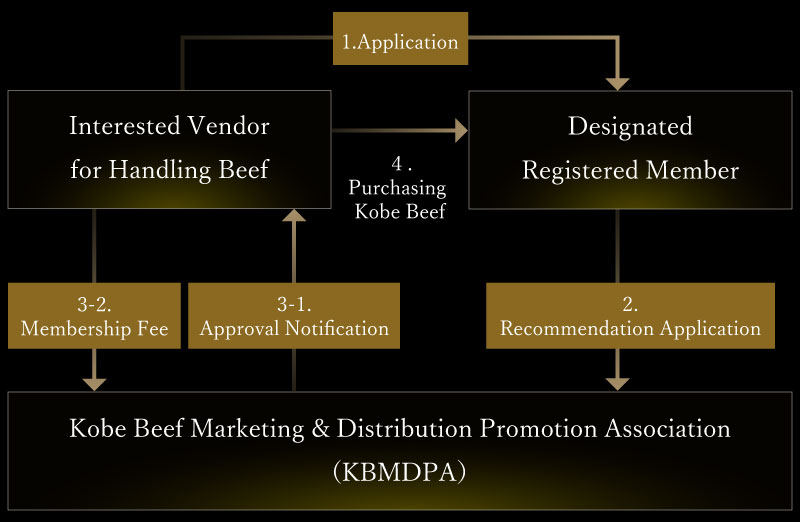
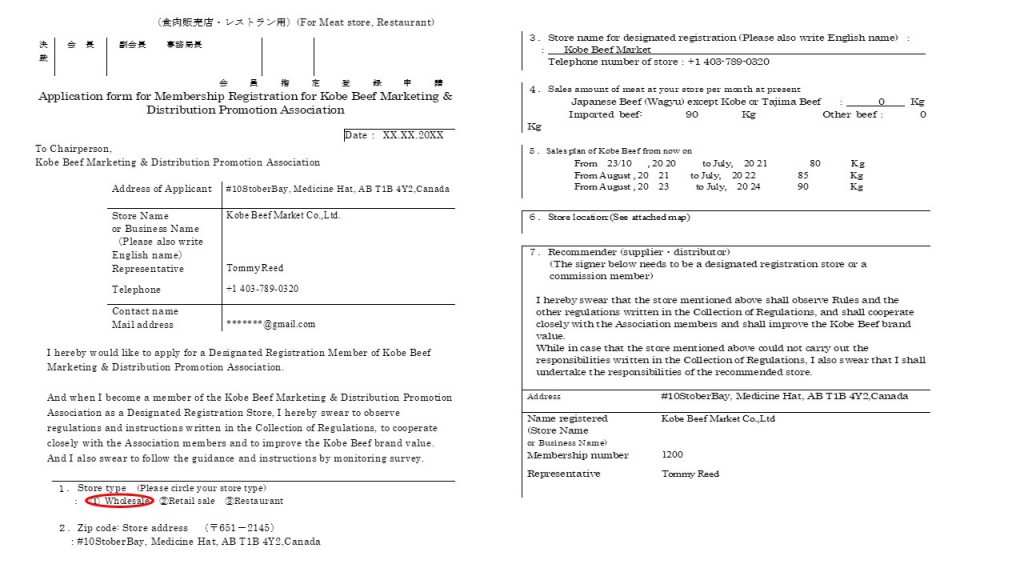
Requirements for Meat Stores and Restaurants
- The restaurant is required to consistently offer Tajima Beef and Kobe-niku / Kobe Beef / Kobe-gyu, either for direct sale or as part of meat dishes, while adhering to applicable laws, ordinances, and regulations related to meat.
- Additionally, the store is required to submit an annual report detailing the quantity of Kobe Beef handled to the Kobe Beef Marketing & Distribution Promotion Association.
- Meat stores must prominently display the membership certificate (monument) and the Kobe Beef / Tajima Beef Certificate of Authenticity. They should also ensure fair beef sales by appropriately labeling the parts of the beef.
- Restaurants are expected to showcase the membership certificate (monument) and the Kobe Beef / Tajima Beef Certificate of Authenticity. Additionally, they should possess exceptional cooking skills and techniques, providing customers with high-quality beef at fair prices.
- Suppliers of Tajima Beef or Kobe-niku / Kobe Beef / Kobe-gyu must hold either Association membership or Designated Registration Member status.
Compliance Matters for Meat Stores and Restaurants
- Meat stores and restaurants affiliated with the Association are required to prominently display both the Certificate of Designation (framed certificate) and the membership certificate (monument: bronze statuette) at all times.
- Stores selling Tajima Beef or Kobe-niku / Kobe Beef / Kobe-gyu must allocate a dedicated Kobe Beef corner, displaying the Tajima Beef or Kobe Beef Certificate of Authenticity issued with the meat carcass. Additionally, they should label the parts of the meat to ensure fair Kobe Beef trade in accordance with the law.
- In the event that monitoring members, commissioned in accordance with Article III of the Handling Procedures, find it necessary to investigate and provide guidance, cooperation is expected and should not be refused.
- The annual volume of Tajima Beef or Kobe-niku / Kobe Beef / Kobe-gyu handled (from August 1 of the previous year to the end of July of the current year) must be reported to the Association at the end of the year using the prescribed form.
Supplier Changes and Membership Withdrawal Procedures
- In the event that a designated registered store undergoes a change in its participating introducer, the store is required to notify the change using the prescribed format.
- If a designated registered store decides to discontinue trading Kobe Beef, it must submit a notice of withdrawal and simultaneously return the lent Certificate of Designation, Membership Certificate, and Kobe Beef declaration plaque.
To contribute to the ongoing enhancement of Kobe Beef’s brand strength, it is advisable for entities engaging with Kobe Beef to have a comprehensive understanding of the Kobe Beef Marketing & Distribution Promotion Association’s system before entering into transactions.
For restaurants and retailers who want to sell Kobe beef
Click here to find a designated registered store (not a registered restaurant) . Contact the chosen store to express your interest in becoming a designated registered member.
Use ‘Area select’ to search for your desired region and choose from ‘Retail sale,’ ‘Wholesale,’ and ‘Online retail’ under ‘Category select.’
Looking for a restaurant where you can eat or purchase Kobe beef? Search for participating stores here.
Search for your desired area using ‘Area select’ and choose from ‘Retail sale,’ ‘Restaurant,’ and ‘Online retail’ under ‘Category select.’
About Kobe Beef Farmers
Producers of Kobe Beef include both ‘breeding farmers,’ who raise Tajima beef calves, the ‘motoushi’ (purebred seedstock cattle) for Kobe Beef, and ‘fattening farmers,’ who import motoushi from the calf market and fatten them. There are two types of farmers.
Fattening farmers select calves at the livestock market based on their pedigree, past performance, bone structure, and coat. They then raise them with care and love for about two years after the purchase.
All cattle on the farm are Tajima beef. ‘Kobe Beef’ is reserved exclusively for Tajima beef that successfully meets stringent screening standards and is processed into meat.
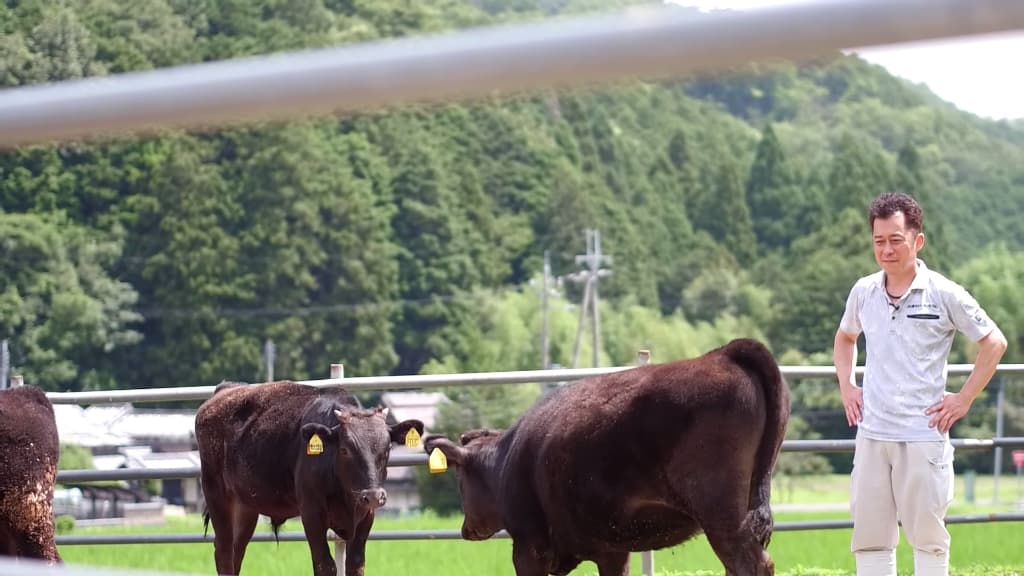
Differences and Challenges in Fattening Kobe Beef Compared to Other Prefectures
Tajima beef is naturally smaller than cattle from other prefectures at birth, and it distinguishes itself from Wagyu cattle in other regions by being challenging to raise to a larger size. Due to their smaller and delicate nature, it is crucial not only to maintain them but also to view them from the same perspective and trust each other.
Farmers diligently monitor the physical condition of their cows, addressing their needs on a daily basis. The production of high-quality meat is achieved by creating an optimal environment for the cattle, including the use of misting.
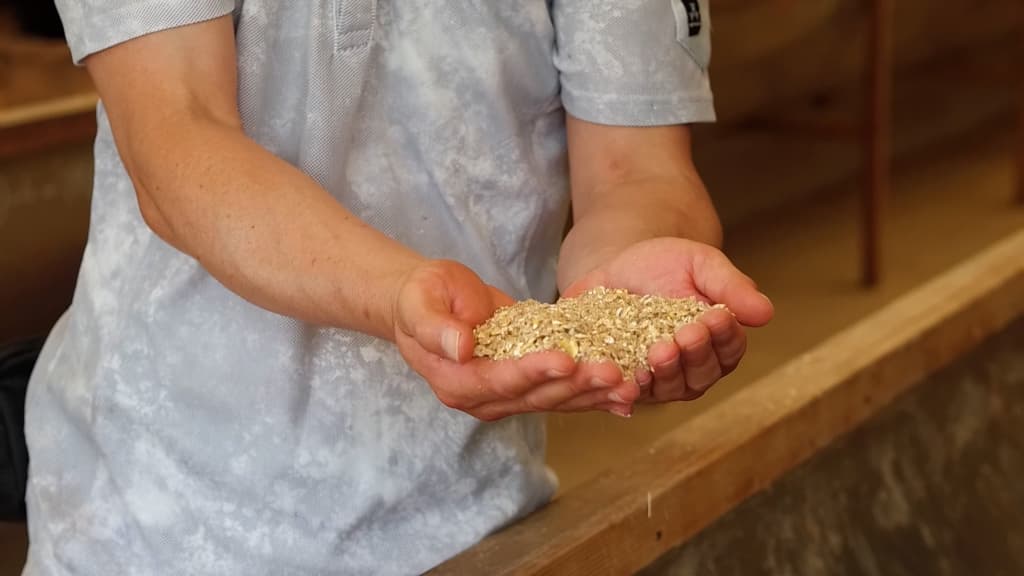
Environmental Stewardship and Nutritional Commitment
Hyogo Prefecture, characterized by its mountainous terrain and significant temperature variations, poses challenges for cattle ranging from sub-zero temperatures in winter to over 30 degrees Celsius in summer. With these extremes, the cattle thrive, and farmers consistently yield high-quality meat.
The feed primarily comprises wheat, corn, bran, and soybeans. Naturally, the dietary requirements vary from calf to adult, and we ensure to provide the right nutrition at the right stages of development.
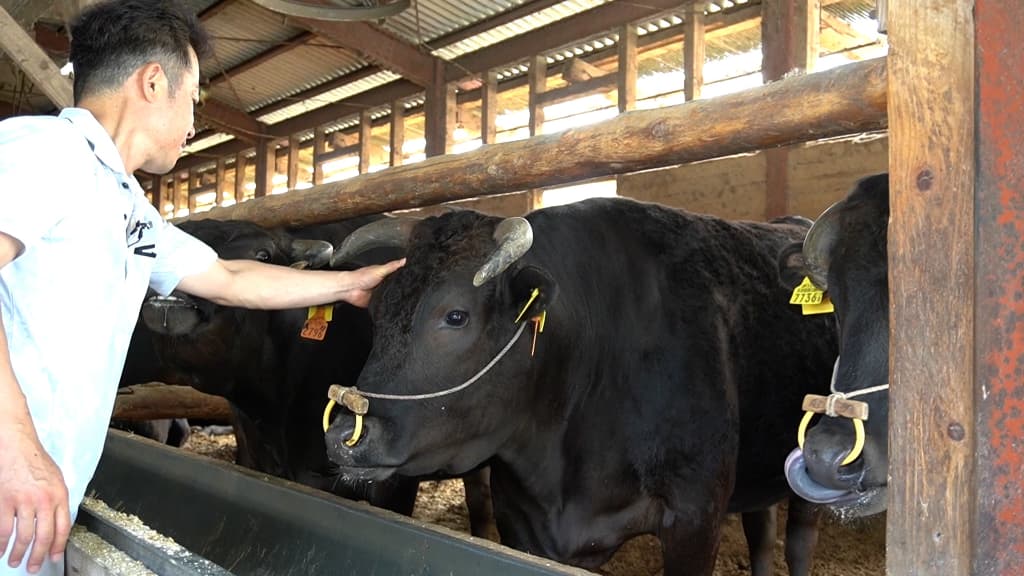
Key Points for Identifying High-Quality Beef Cattle
High-quality meat is always visible on the surface of the body. A cattle with a well-defined body shape, bone structure, and bone thickness typical of Tajima beef exhibits both excellent meat and fat quality. Fattening farmers are required to possess the skills necessary for producing top-quality cattle.
Animal Welfare and Hygiene Management at Meat Centers
The fattened Tajima beef is transported to and slaughtered at a designated meat center in Hyogo Prefecture. Only those that meet strict inspection standards are certified as Kobe Beef.
Each facility prioritizes animal welfare and implements thorough hygiene management. We will showcase our efforts, using Wagyu Master as an important export base.
Designated Meat Center in Hyogo Prefecture
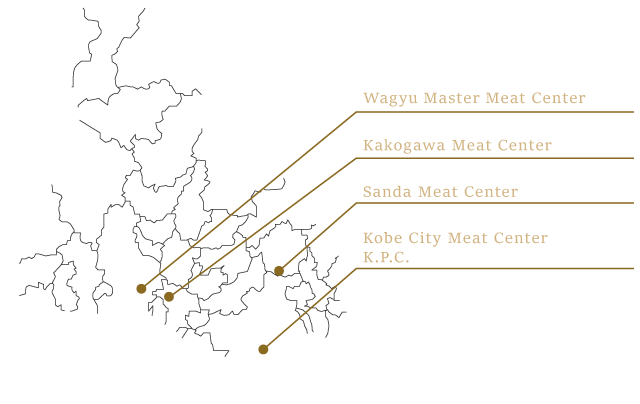

Animal Welfare Practices at Wagyu Master
At Wagyu Master, we meticulously handle everything from loading to mooring to butchering to ensure the well-being of the cattle and minimize stress.
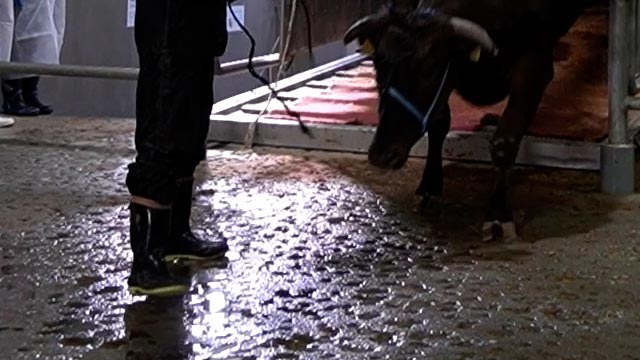
The facility features uneven floors designed to prevent cattle from getting caught in their claws and to provide a more comfortable standing surface.
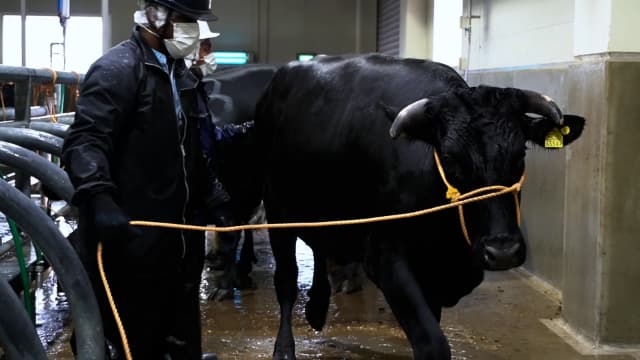
We prioritize natural movement, allowing cattle to freely walk in and out of the mooring area or standing box without force. Our approach involves gentle guidance without the use of electric whips or pushing from behind.
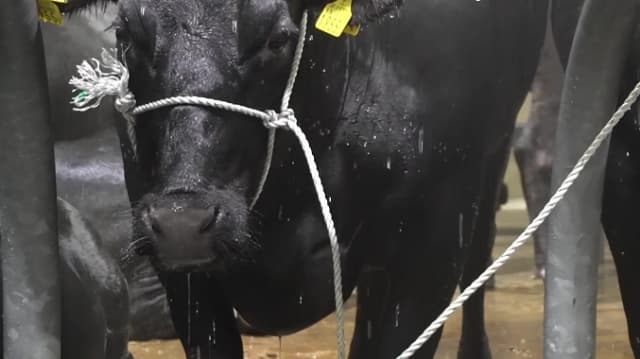
When guiding the cattle, we are cautious not to pull the string excessively, check for bridle, ensure the string is not passed through the nose plug, and verify the cattle is not in distress.
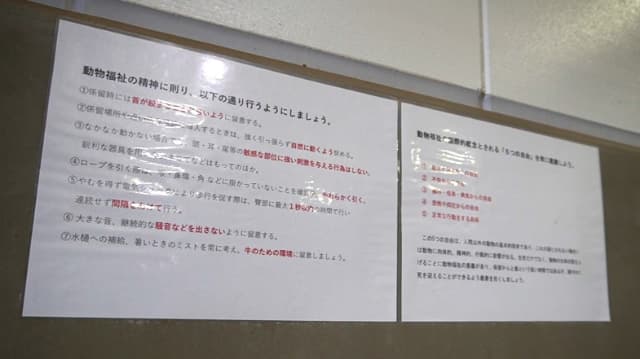
Our staff undergo regular training on animal welfare, and we actively disseminate this information to farmers and transporters for wider awareness.
Hygiene Management Practices at Wagyu Master
At Wagyu Master, we conduct slaughtering, market management, and meat processing (carcass cutting) under Japan’s first-class hygiene management standards.
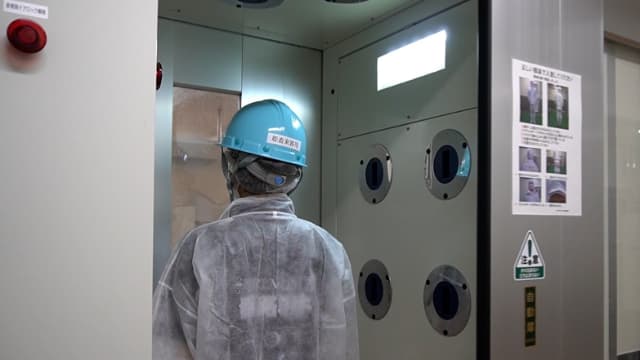
All employees and visitors at Wagyu Master are required to wear a hair cap, white coat, and boots. They must wash their hands, use a sticky roller to remove dust from work clothes, and take an air shower when entering and leaving the slaughterhouse, cutting area, viscera processing section, processing plant, and product warehouse. These measures ensure that we maintain thorough hygiene management throughout our operations.
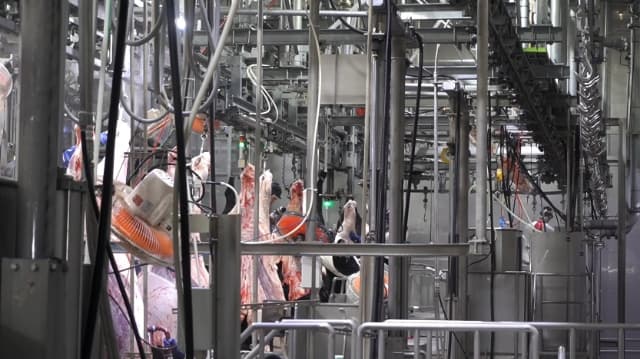
Demolition work is performed under strict hygiene control at the demolition site. After slaughter, the carcass undergoes a comprehensive inspection by a meat inspector before being transported to the warehouse.

Carcasses that pass inspection are then taken to the carcass store and thoroughly chilled. Even before entering the carcass warehouse, inspection, storage and dispatch are carried out under strict hygiene controls.
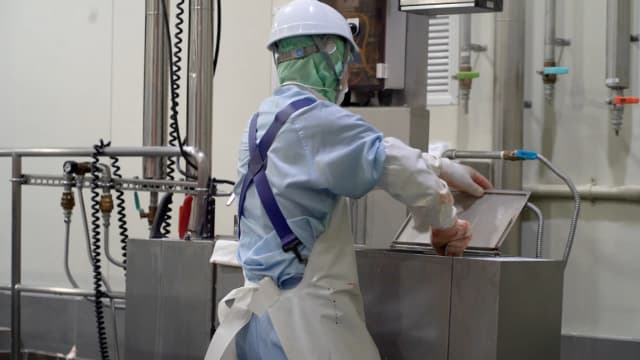
After the auction, once a buyer has been determined, the pieces are cut for the orders of individual stores and wholesalers. In addition to disinfected and cleaned knives and cutting boards, all tools used undergo sterilization in boiling water after each job.
Thanks to these rigorous hygiene management practices and the meticulous work of all our employees, we can provide you with delicious meat.
For restaurants and retailers who want to sell Kobe beef
Click here to find a designated registered store (not a registered restaurant) . Contact the chosen store to express your interest in becoming a designated registered member.
Use ‘Area select’ to search for your desired region and choose from ‘Retail sale,’ ‘Wholesale,’ and ‘Online retail’ under ‘Category select.’
Looking for a restaurant where you can eat or purchase Kobe beef? Search for participating stores here.
Search for your desired area using ‘Area select’ and choose from ‘Retail sale,’ ‘Restaurant,’ and ‘Online retail’ under ‘Category select.’
